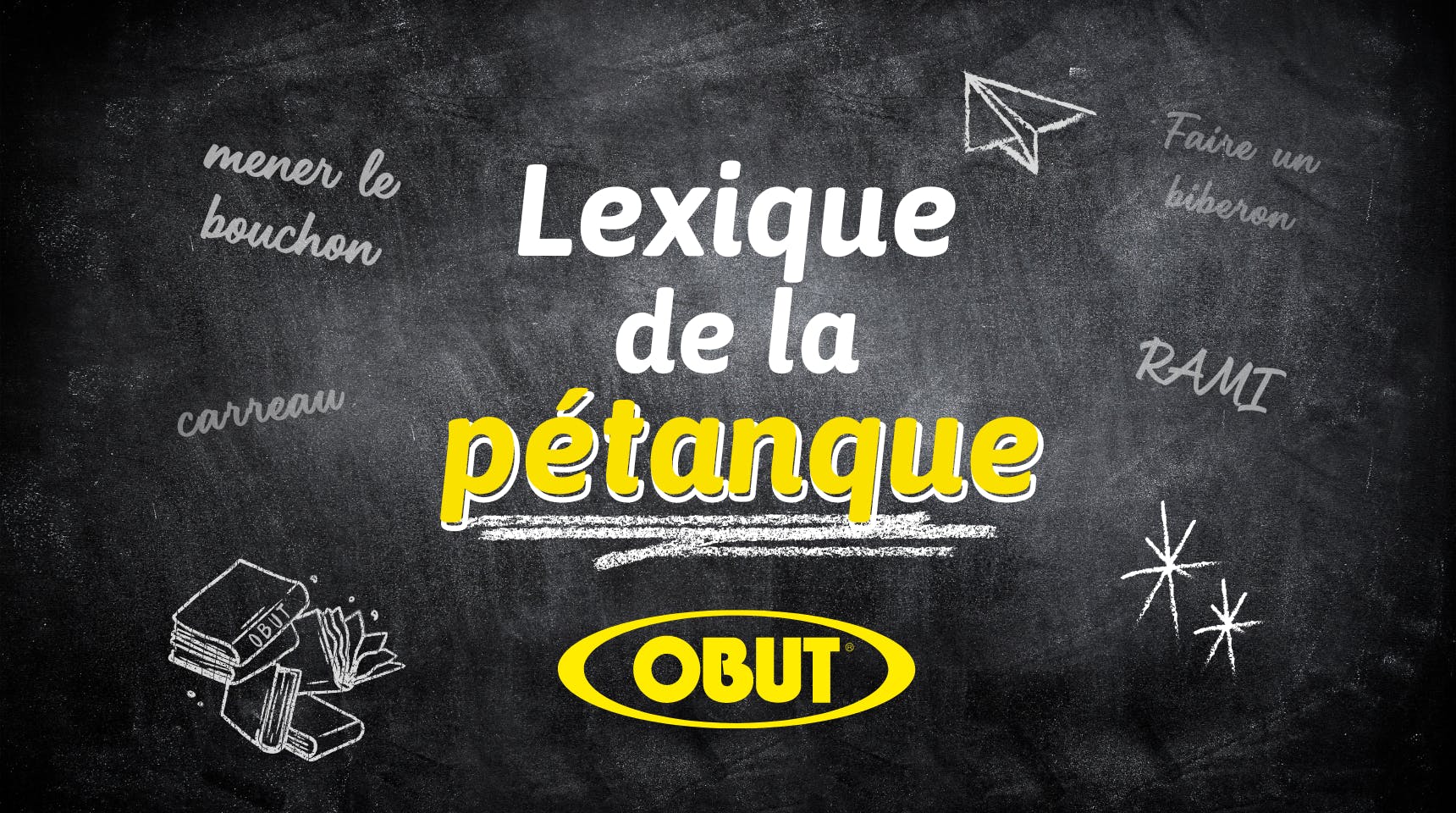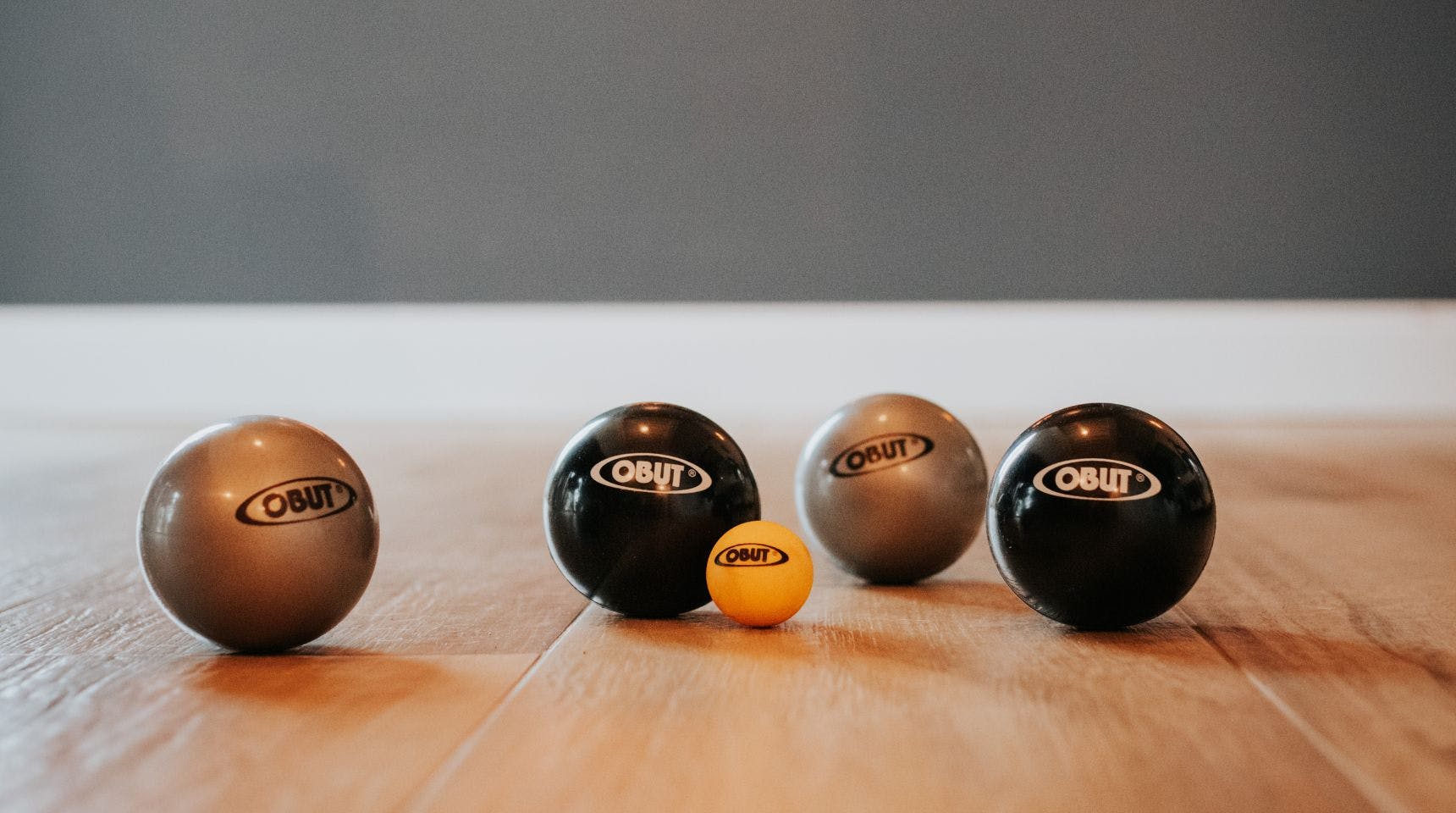
04/12/2024
Glossary of pétanque terms
The vocabulary of pétanque players
Petanque vocabulary is full of colourful, picturesque terms that reflect the richness and tradition of the sport. This colourful vocabulary contributes to the charm and conviviality of pétanque. Petanque players like to use this language to create a unique atmosphere around the court.

The dialect of the pétanqueur
- AJOUTER (to add) : To take one or more additional points.
- ARRIVER A BATAILLE # (literally “to get to battle”) : When both teams have between 10 and 11 points, either side may lose or win the game during every lead. This gives the game a special intensity and attracts considerably more spectators, giving players emotions that are discouraged by cardiologists!
- ADVANTAGE (to have the) : To have more boules left to play than your opponent; or, if you have an equal number of boules, to “have” or “hold” (i.e. to be winning) the point.
- BATI-BATI# (literally “Frame-Frame”)) : To “have bati-bati” means to lose your cool at a decisive stage of the game, for example, when the score is at 12/12.
- BOUCHE (MOUTH): A “bouche” is a loudmouth braggart, who speaks more than he acts. To “shoot in the mouth” means to do a direct hit stun shot.
- BRAQUER (TO STARE): To stare at your opponent to distract him while he is shooting.
- BRAS (ARM): The part of the body of champions most coveted by other players, who say things like "If I had an arm like him...". These champions are called “gros bras” (“strong arms”), or Golden Arms.
- BUT (literally “goal”, i.e., the JACK): Also called the bouchon, cochonnet, petit, gari or kiki, it is a small wooden ball 35 mm in diameter.
- BUT NOYÉ# (literally “DROWNED” JACK): A jack that is unplayable because it cannot be seen from the playing circle.
- CABANON (literally “cabin”): In southern France, many family pétanque games took place on Sunday at their cabanon (weekend cabin). When these players occasionally took part in a contest, they were referred to as "cabin players".
- CADRE (FRAME): Laid-out pitch, especially in championships (official dimensions: 4 m wide, 15 m long).
- CASSER LE BRAS# (BREAK THE ARM): To distract a shooter, with a movement or a noise nuisance just when he is shooting.
- CIRCLE (or “rond”/ring): Circle from within which boules are thrown.
- CHIQUER# (literally “to chew”): To lightly touch a boule on the side.
- CROCHET# (HOOK): A shot played badly due to incorrect opening of the hand. May be the result of excess pressure, fatigue, or cold. Also known as ganchou or carpe (carp), brochet (pike) or écart (gap).
- DEMARQUER# (literally “to un-score”): Taking a point away from your own team when either pointing or shooting.
- ESCAGASSER*#: In southern France, to trounce your opponent.
- FAIRE LA PIECE (to toss the coin): To toss a coin to see who will start the game.
- FAIRE LES MAINS (literally “to make hands”): To play alone with 6 boules against a team of two or three players.
- FANNY: According to tradition, when players lose 13-0 then, as a humiliation, they must kiss the buttocks of a woman (or sometimes a donkey) called Fanny (usually a cardboard cut-out, etc.).
- FUSER (SHOOT AWAY): When a boule that hits the ground incorrectly and suddenly shoots away off course.
- GALLERY: All the spectators watching a game.
- GRATTON: A mythical small stone which, together with a pine nut and a “bad hit”, are (supposedly) the causes of all badly-played shots.
- JOUER SOUS MAIN (TO PLAY UNDERHAND): To play your boule with your palm facing the ground.
- JOUER SUR MAIN (TO PLAY OVERHAND): To play your boule with your palm facing the sky.
- MELEE#: A draw for forming teams.
- MENE# (END): A phase of a game of bowls that ends when both teams have played all their bowls or when the jack is lost (or knocked outside the pitch).
- MORDRE# (TO BITE): To put your foot or feet outside the ring of the circle.
- RAMI*#: To play a great shot with a little luck.
- REFENTE# (SPLIT): To “split” or open up the game by knocking into a group of boules and hoping to end up close to the jack.

Expressions on point
- BEC# (literally ”peck”): To change the course of a pointed boule so that it just touches another boule on the side: it is said to “give a little peck on the cheek” of the other boule.
- BIBERON# (“to make a biberon” = literally “to prepare a baby’s bottle”): To place a boule adjoining the jack.
- DEMI-PORTEE (HALF-RANGE): To point by throwing your boule to about midway between the circle and the jack.
- DEVANT DE BOULE: To “make a devant de boule” means to place your boule in front of your opponent’s, taking the lead and making it difficult for your opponent to shoot.
- DONNEE#: When pointing, the precise location where you want your boule to land on the ground before rolling.
- EMBOUCHONNER#: To “prepare a baby’s bottle” (biberon).
- ENVOYER (SEND): To bring a boule to near the jack.
- JOUER NAUTURE#: To “play nauture” means to point without any effect.
- MENER LE BOUCHON# (TO LEAD THE JACK): To play as pointer and therefore to throw the jack.
- PORTEE (SPAN or RANGE): To “do a portée” means to lob a boule high so that it falls almost vertically near the jack or a boule.
- POUSSETTE# (literally “LITTLE PUSH” or “push shot”): To push one or more of your team’s boules toward the jack or to push the jack.
- ROULETTE#: Near the circle, the boule is rolled sharply to the jack.
Shooting expressions
- AGANTER*: To catch, hit, get, clear. This refers to hitting the opponent’s boule. Used in the imperative, "Go on Bert, agante it!", as an encouragement to your pointer. If you inadvertently “agantez” one of your own boules, it's called “killing the dog”.
- BOMBARD: To shoot or strike your opponent’s boules one after the other, after the opponent has taken the lead.
- CARAMBOLAGE (PILE-UP): A powerful shot that knocks away several boules at once.
- CARREAU# (literally “tile”, meaning a direct stun shot): The shooter's boule takes the place of the boule it has just hit (also known as fly, egg, freezing, buffet stop, or patch).
- CASQUETTE# (literally “CAP”): An unfortunate strike shot in which the shooter’s boule just brushes the top of the targeted boule and 'caps' it for a split second but fails to knock it away.
- CONTRE (literally “counter”): May be beneficial or not. A boule that is struck by a shooter lands on another boule (of his own team or the opponent’s team) or onto the jack.
- ESTANQUE*# : Comes from the word pétanque: a strike that remains in place; a palet (puck) or carreau.
- PALET (PUCK): To “do a palet” means to shoot just in front of a boule and knock it away while remaining within 50 cm of the jack.
- RASPAILLETTE# : A rolled shot that is regarded with contempt by experts. The shooter’s boule falls 2 or 3 metres from the targeted boule and drives it away while rolling.
- SAUTER (JUMP): To “jump” a boule means to miss a strike shot at a boule and then fall just behind it.
- TROU (HOLE): To make a hole means to miss a strike shot. The boule hits the ground instead of its target, and leaves a mark (a hole).
- TIR A LA SAUTEE# (JUMPING STRIKE): To shoot or strike a boule that is hidden behind another one.
- TIRER AU FER#: To “shoot the iron”: to knock away a boule without touching the ground.
- TIRER A LA RAFLE# (do a ground shot): To shoot with power, virtually at ground level.
Article selection Obut





